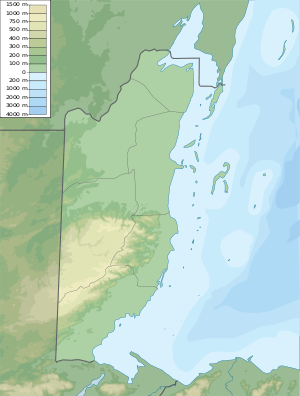Chalillo Dam
The Chalillo Dam is a gravity dam on the Macal River about 33 km (21 mi) south of San Ignacio in Cayo District, Belize.[2][3] Chalillo Dam's capacity was premeditated to be only 7.0MW.[4] The dam was constructed by Sinohydro of Beijing, China between 2002 and 2005 with the primary purpose of hydroelectric power production.[5] It is owned and operated by Belize Electricity Limited (BEL). The project budget was approximately US 30 million and included at least 350 Belizean construction workers. Its construction generated controversy over its effect on the surrounding rain forest. Two smaller dams, the Mollejon and Vaca, are downstream from the Chalillo Dam.
| Chalillo Dam | |
|---|---|
 Location of Chalillo Dam in Belize | |
| Country | Belize |
| Location | Cayo |
| Coordinates | 16°51′41.09″N 89°00′47.56″W |
| Purpose | Power |
| Status | Operational |
| Construction began | 2002 |
| Opening date | 2005 |
| Dam and spillways | |
| Type of dam | Gravity, roller-compacted concrete |
| Impounds | Macal River |
| Height | 45 m (148 ft) |
| Height (foundation) | 380 m (1,250 ft) |
| Dam volume | 140,000 m3 (180,000 cu yd) |
| Reservoir | |
| Total capacity | 120,000,000 m3 (97,000 acre⋅ft) |
| Installed capacity | 7 MW[1] |
Location
Chalillo Hydroelectric Dam is situated in the Western most part of the country where the Macal River converges with the Raspaculo River. It is located in the Maya Mountains and shares adjacency with the Chiquibul National Park and the Pine Ridge Forest Reserve. Positioning Chalillo Hydroelectric Dam approximately 16 kilometers from the Guatemalan border.
Purpose
The primary purpose of Chalillo Hydroelectric Dam is to impound the water in the 46m storage dam during the rainy season and release during shortage.[6] At the base of the dam, through a low level valve, water is released during the dry period. Basically, water is carried from the dam downstream to the powerhouse which protects the generating Kaplan turbines. Subsequent to powering the electric turbines, the water drifts back into the Macal River through the tailrace channel and back to its natural route towards its sister facility, Mollejon hydroelectric power plant.
Production
All necessary equipment and controls required for the production of power is contained in the Power House. The circular steel pen stock which is about 80 meters in length and 2.4 meters in diameter facilitates the transport of water from the dam to the power plant. The Kaplan turbine generators equipped with adjustable blades, modern electronic and hydraulic systems help in the production of power. Subsequently, the power is delivered through the 115Kv line which is interconnected to Mollejon switchyard. Power is then distributed to BEL’s grid via Mollejon.
Advantages
There are vast environmental issues with the existence of Chalillo hydroelectric dam; this dam contributes a minimal amount of the country’s demand for electricity. It does not limit the import of electricity, thus does not decrease energy dependency by supplying minimal power.
References
- "Belize, Chalillo Dam". SinoHydro. Archived from the original on 22 February 2014. Retrieved 14 February 2014.
- Reid, J. (2000). Analysis of the Final Feasibility Study and Environmental Impact Assessment for the Proposed Chalillo Dam. Retrieved 16 February 2017, from "Archived copy" (PDF). Archived (PDF) from the original on 2017-03-04. Retrieved 2017-03-04.CS1 maint: archived copy as title (link)
- Sarah Bradshaw, "Amid utilities' plan, a dam controversy", Poughkeepsie Record-Journal, June 8, 2013 Archived June 13, 2013, at the Wayback Machine
- Soubrier, Géraud (March 2006). "Belize Electric Company Ltd. Belize Hydroelectric Development Technical Report" (PDF). Archived (PDF) from the original on 2017-03-04.
- "Chalillo (search term)". RCC Dam Database (Malcolm Dunstan & Associates). Archived from the original on 23 September 2006. Retrieved 14 February 2014.
- Belize Produces Electricity with Chalillo Dam. (2006). The Island Newspaper. Retrieved 16 February 2017, from "Archived copy". Archived from the original on 2017-03-05. Retrieved 2017-03-04.CS1 maint: archived copy as title (link)